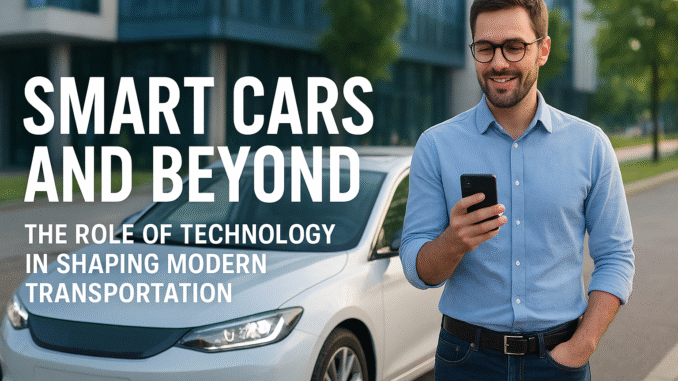
Smart Cars and Beyond: The Role of Technology in Shaping Modern Transportation
The world of transportation is changing faster than ever before. For decades, cars were primarily mechanical machines designed to get us from one place to another. Today, however, vehicles are becoming more intelligent, connected, and sustainable thanks to advances in technology. From smart cars equipped with AI to futuristic concepts like autonomous mobility and smart infrastructure, the transportation sector is undergoing a revolution that affects not just how we travel, but how we live and work.
In this article, we’ll explore how technology is shaping modern transportation, the impact of smart cars, the role of connectivity, the rise of automation, and the innovations set to define the future of mobility.
What Are Smart Cars?
Smart cars, also called connected cars, are vehicles that use advanced technology to provide features beyond traditional driving. These cars are often equipped with sensors, artificial intelligence (AI), wireless internet, and integrated software systems that allow them to communicate with drivers, other vehicles, and infrastructure.
Key features of smart cars include:
- Driver-assistance systems such as lane-keeping, adaptive cruise control, and collision warnings.
- In-car connectivity that integrates smartphones, voice assistants, and navigation.
- Real-time diagnostics for vehicle performance and predictive maintenance.
- Autonomous driving features that can take partial or full control of the vehicle.
Smart cars represent the blending of technology and transportation, creating safer, more efficient, and more enjoyable travel experiences.
The Rise of Connected Transportation
The idea of vehicles that “talk” to each other or to infrastructure may have once sounded like science fiction, but it is becoming reality. Known as vehicle-to-everything (V2X) communication, this technology allows cars to connect with:
- Other vehicles (V2V): For preventing accidents by sharing speed and location data.
- Infrastructure (V2I): Such as traffic lights, toll booths, or smart parking systems.
- Pedestrians (V2P): Enhancing safety by detecting people crossing roads.
- The Cloud (V2C): Accessing navigation, weather, or road condition updates in real-time.
This level of connectivity is a cornerstone of modern transportation. It reduces traffic congestion, enhances road safety, and makes cities more efficient by using data to optimize traffic flow.
Autonomous Vehicles: The Next Frontier
Perhaps the most talked-about innovation in transportation is the autonomous vehicle (AV), or self-driving car. While still in development, companies like Tesla, Waymo, and traditional automakers are making significant strides toward fully autonomous cars.
Levels of Automation
The Society of Automotive Engineers (SAE) defines six levels of vehicle automation, from Level 0 (no automation) to Level 5 (full automation with no driver needed). Today, many cars operate at Level 2 or Level 3, offering advanced assistance but still requiring driver supervision.
Benefits of Autonomous Vehicles
- Safety: Most accidents are caused by human error. Autonomous vehicles have the potential to drastically reduce crashes.
- Efficiency: Self-driving cars can optimize speed and routes, reducing congestion and fuel consumption.
- Accessibility: They can offer mobility solutions for elderly or disabled individuals.
- Convenience: Autonomous cars free up time for passengers to work, relax, or socialize during travel.
While there are still regulatory, ethical, and technological challenges, autonomous vehicles are expected to reshape personal and public transportation in the next decade.
The Role of Artificial Intelligence
Artificial intelligence (AI) is at the core of modern transportation technology. From powering self-driving algorithms to enabling voice recognition systems in vehicles, AI is everywhere.
- Computer vision allows cars to “see” and interpret their surroundings using cameras and sensors.
- Machine learning enables continuous improvement as vehicles gather and analyze driving data.
- Predictive analytics help with route optimization, maintenance scheduling, and fuel efficiency.
AI also plays a role beyond cars, powering smart traffic lights, automated logistics systems, and even drone delivery services.
Electric Vehicles and Sustainability
The push toward sustainability is one of the strongest drivers of innovation in transportation. Electric vehicles (EVs) are central to this shift, as they replace gasoline engines with clean, battery-powered alternatives.
Smart EVs not only reduce emissions but also integrate with technology to improve user experience:
- Smart charging systems that allow vehicles to charge during off-peak hours.
- Integration with renewable energy sources like solar or wind.
- Bidirectional charging, where EVs can supply power back to the grid.
The combination of electrification and smart technology is helping build an eco-friendly transportation ecosystem that supports global climate goals.
Smart Infrastructure: Cities of the Future
Modern transportation is not just about smarter cars—it’s also about smarter cities. Infrastructure must evolve to support connected and autonomous vehicles.
Examples of smart infrastructure include:
- Intelligent traffic signals that adapt to traffic flow in real time.
- Smart highways equipped with sensors to monitor conditions and guide vehicles.
- Digital parking solutions that help drivers locate available spaces quickly.
- Mobility-as-a-Service (MaaS) platforms that integrate different transport modes into a single app.
By combining data from vehicles, sensors, and public systems, smart infrastructure helps reduce congestion, lower emissions, and improve safety.
Transportation Beyond Cars
Technology is not only transforming cars but also revolutionizing other forms of transportation.
- High-speed rail systems like Japan’s Shinkansen or future hyperloop projects promise ultra-fast, efficient travel.
- Electric buses and trucks are being adopted for sustainable public transport and freight logistics.
- Urban air mobility (UAM), including drones and electric air taxis, could redefine short-distance travel.
- Micromobility solutions such as e-scooters and e-bikes are providing convenient last-mile connectivity.
This multimodal approach ensures that technology-driven transportation is not just about personal cars, but about creating a holistic ecosystem of mobility.
Challenges and Concerns
While technology is driving progress, it also presents new challenges.
- Privacy and Data Security: Connected cars collect massive amounts of data, raising concerns about cybersecurity and personal privacy.
- High Costs: Smart vehicles and infrastructure require significant investment, which may slow adoption.
- Job Displacement: Automation could impact employment in driving, logistics, and related sectors.
- Ethical Dilemmas: Self-driving cars must make decisions in critical situations, raising questions about responsibility and ethics.
- Digital Divide: Access to smart transportation may not be equal across different regions or socioeconomic groups.
Addressing these issues will be crucial for ensuring that modern transportation benefits everyone.
The Future of Transportation
Looking forward, technology promises to create a transportation system that is safer, greener, and more connected. Some key trends shaping the future include:
- Fully autonomous ride-sharing fleets that replace individual car ownership.
- Integration of transportation with smart homes and devices, allowing seamless travel planning.
- AI-powered logistics systems that deliver goods faster and more sustainably.
- Expansion of electric and hydrogen-powered vehicles for long-distance travel.
- Global adoption of MaaS platforms, uniting cars, buses, trains, bikes, and flights under one digital ecosystem.
The future of transportation is not about cars alone, but about creating a connected world where mobility is efficient, inclusive, and environmentally responsible.
Conclusion
Technology is reshaping transportation in ways that were unimaginable just a generation ago. Smart cars, autonomous driving, artificial intelligence, and sustainable innovations are not just trends—they are the building blocks of the future.
As the world embraces these changes, the benefits are clear: safer roads, cleaner environments, and greater accessibility. At the same time, addressing challenges around costs, ethics, and infrastructure will determine how quickly and equitably this future becomes reality.
From smart cars to smart cities, the role of technology in shaping modern transportation is undeniable. We are not just driving into the future—we are reimagining the very meaning of mobility.

